A writing portfolio is more than just a writing sample or two thrown together. Sure, those samples will showcase your writing skills and they are certainly the most important part of your writing portfolio website. But, just by themselves, they might not be enough to help your portfolio site stand out and compete in a dog-eat-dog digital economy.
When looking for a freelance writer, clients have their own priorities and budgets, so you can never be too sure about what can repel them from your online writing portfolio (and stop considering you for the job/gig).
However, even though I can't tell you what will get clients interested 100% of the time, I can certainly give you ideas on what seems to make a potential client happy when they visit your online portfolio. I'll do this by showing and discussing 12 incredible writing portfolio examples — the kind that clients immediately love.
The writers behind these portfolios don't just display their best writing. They pay attention to their bio, website navigability, easy contact options, and in some cases, interesting visuals. Now, if you are a freelancer who writes, your freelance writing portfolio doesn't have to resemble a Monet or Degas. But it does have to look clean and invite visitors to scroll further and read more.
Now, let's dive in to see how these writing portfolios meet and exceed the industry standards for excellence, ease of access, and great content.
• Basketball player and coach John Wooden said, “You should never try to be better than someone else, you should always be learning from others. But you should never cease trying to be the best you could be." I agree.
• This advice applies to every aspect of our existence, including the creation of writing portfolios that get you paid by the right clients. So, in this article, we try to learn from the best.
• Have a look at these 12 examples of incredible writing portfolio sites. The people who created and continue to use and update these portfolios are at the top of their field, so they are clearly doing something right. These portfolios are the benchmarks against which you can match your own writing website.
• Next, let's look at a couple of best practices. What should you include in your own online writing portfolio? The major elements are — a great "About Me" section, ALL or most of your work, private sections for ghostwritten work, fluid, navigable website design, and consistently updated content.
• Last, but not least, you'll need a portfolio-building tool to put together or update your site. Visually-inclined creators should choose tools that accommodate and prioritize a portfolio's appearance. Portfolio builders like Squarespace and Carbonmade are perfect examples of such tools. For photographers, there is Adobe Portfolio and SmugMug.
• Writers, on the other hand, would be best served by a tool such as Authory. This portfolio maker's primary advantage is that it does the heavy lifting (finding all your digitally published work) for you. It finds, imports, and stores all your work for you... forever.
12 awesome writing portfolios (includes freelance writing portfolio examples)
Deborah Cornelious
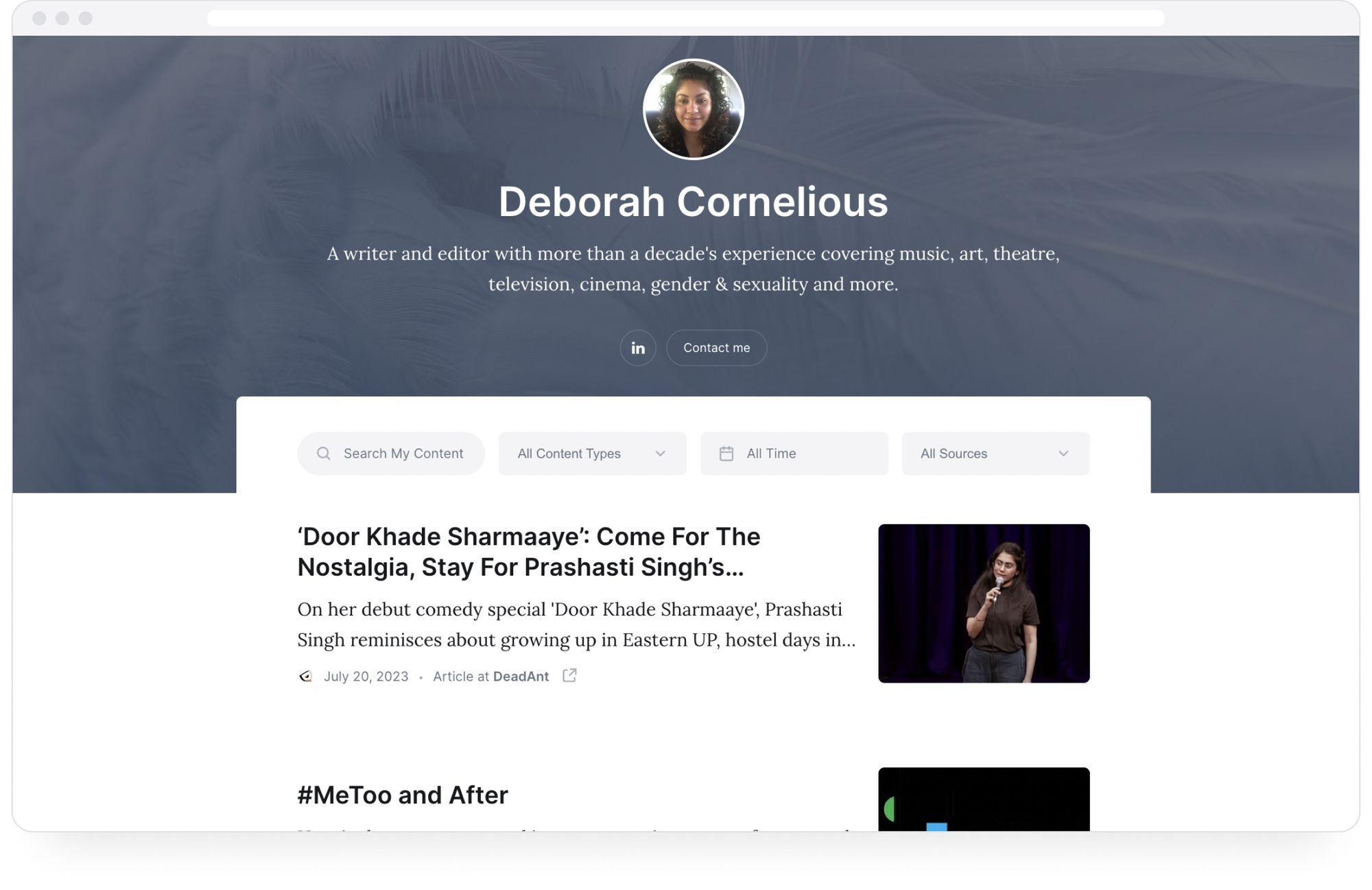
Deborah Cornelious has worked in the media industry for more than ten years. Her experience spans the spectrum across print, TV, and web. According to her LinkedIn, her last job was with Music Plus, "an interactive music communication portal serving as an all-inclusive information hub for the music industry."
This freelance writer has also been an Assistant Editor at The Hindu, one of India’s best-known digital and print news publications. She was part of its Bombay Showcase section, in which she covered culture, cinema, theatre, music & nightlife, gender & sexuality, style, television, and more.
Whitney Cwirka
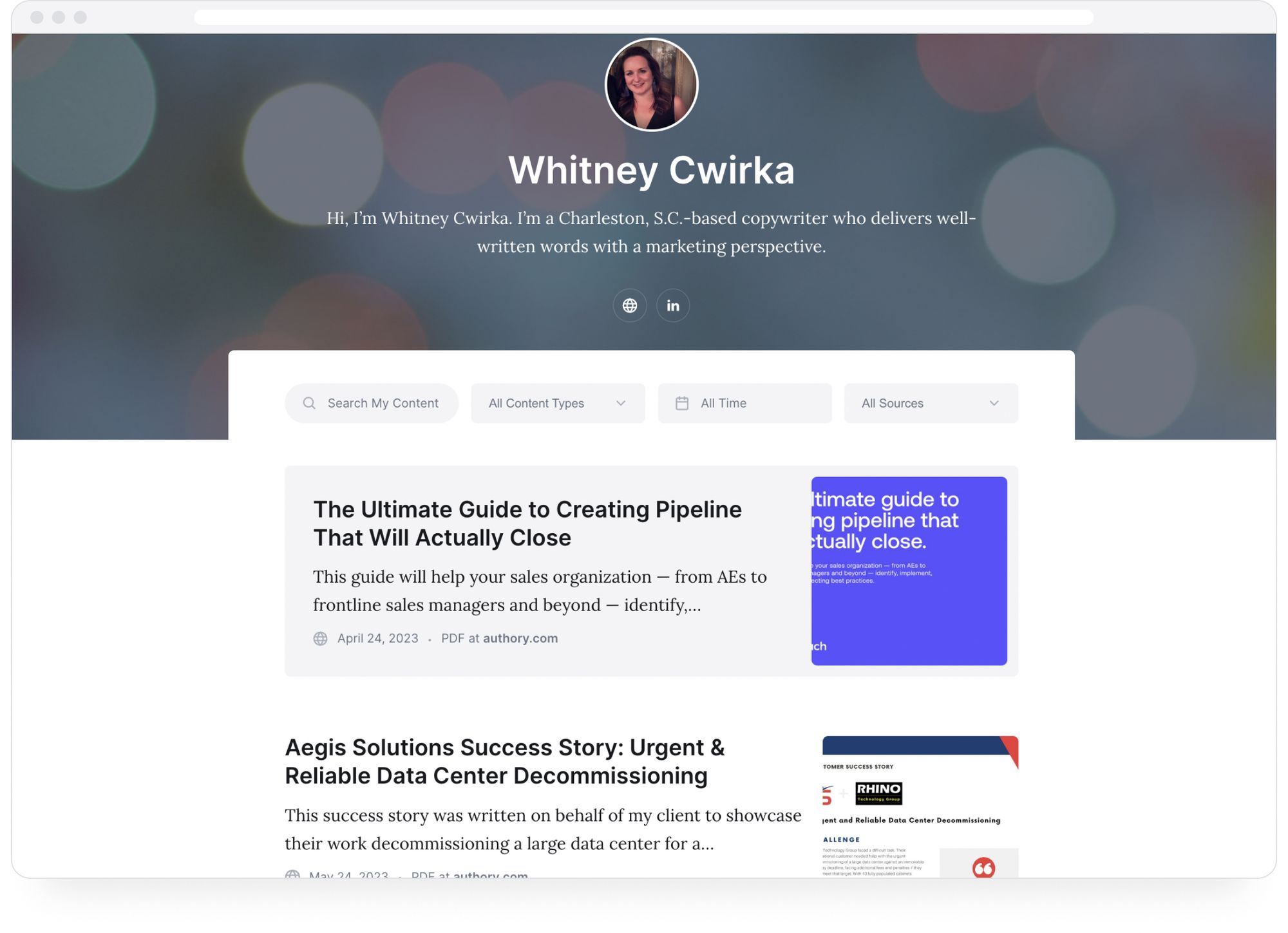
Whitney Cwirka is a Charleston-based copywriter, content strategist, and content writer. She has worked with non-profits as well as tech-first companies, so she has extensive experience in the domain of B2B conversion writing.
Whitney works with companies of all sizes to establish their core messaging, create content strategies, and convey their value through the kind of content that gets people interested enough to convert.
Her specializations include copywriting, leading content strategy, helping with messaging development, and crafting editorial calendars.
Jake Leonard
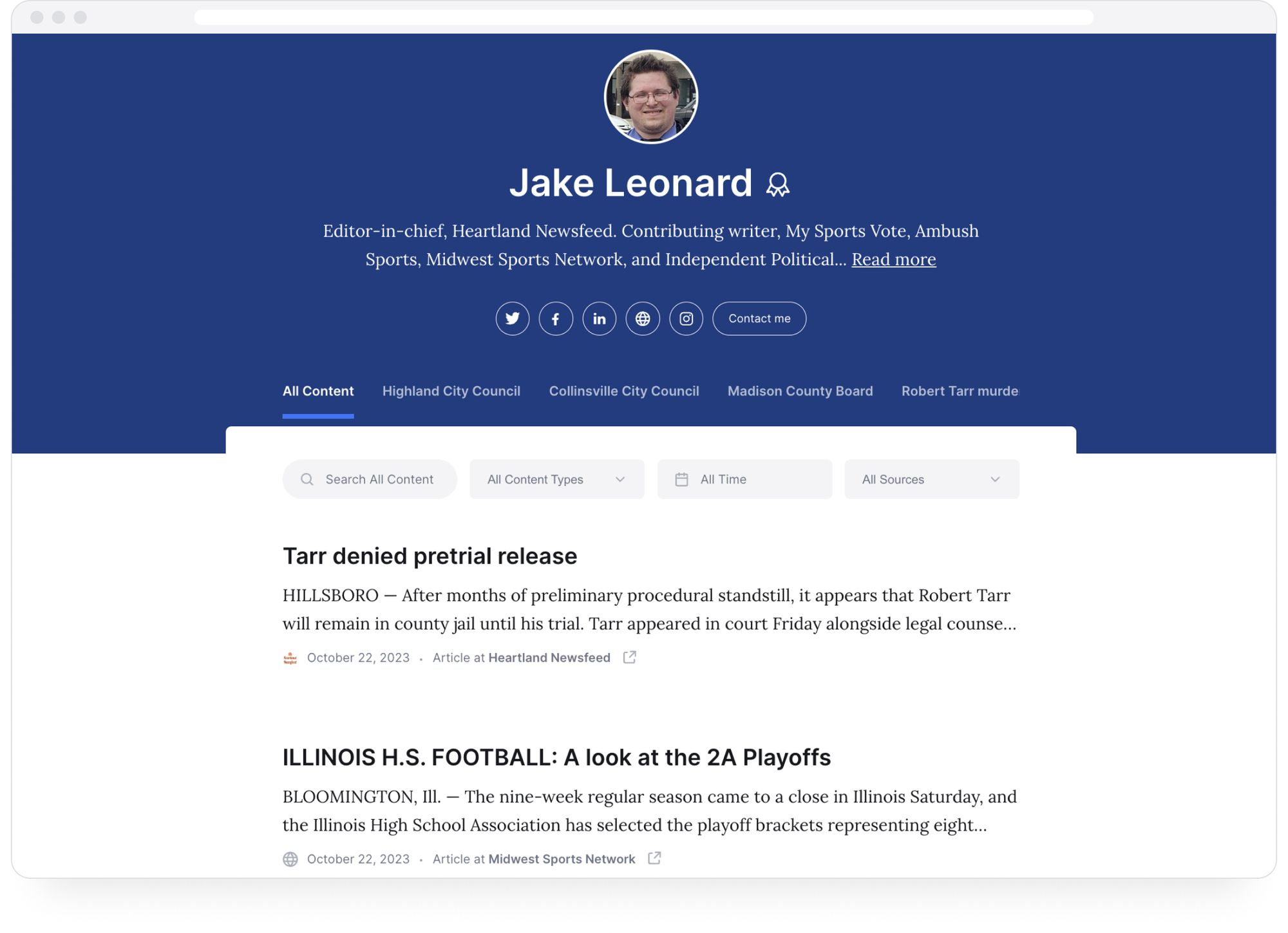
Jake Leonard is currently the editor-in-chief of Heartland Newsfeed. He is also a contributing writer to My Sports Vote, Ambush Sports, Midwest Sports Network, and Independent Political Report. He has been a former contributing writer for Overtime Heroics.
Jake started his first business in 2004 when he was in high school. He first became active in radio in the same year at KCSW-LP @ Culver-Stockton College, Canton, MO. He has held several gigs in terrestrial radio and has been a syndication coordinator with a talk radio network, for podcasts and internet radio.
Jake has been a freelance journalist since 2009, starting with Bleacher Report.
Amal AlTauqi

Amal AlTauqi is a journalist, editor, and publicist based in the UK. She has over 5 years of experience in the industry and has worked with established companies (BBC, The Guardian Newspaper) as well as digital outlets (Link Up TV, GRM Daily, and PAUSE Magazine).
As a freelance journalist, she covers multiple beats, including music, fashion, lifestyle, and traditional news.
Among her pieces, you'll find an exclusive interview with music legend and philanthropist Wyclef Jean as well as a digital magazine cover with rapper Trippie Redd. Clearly, Amal knows what she is doing.
Lavrenty Repin
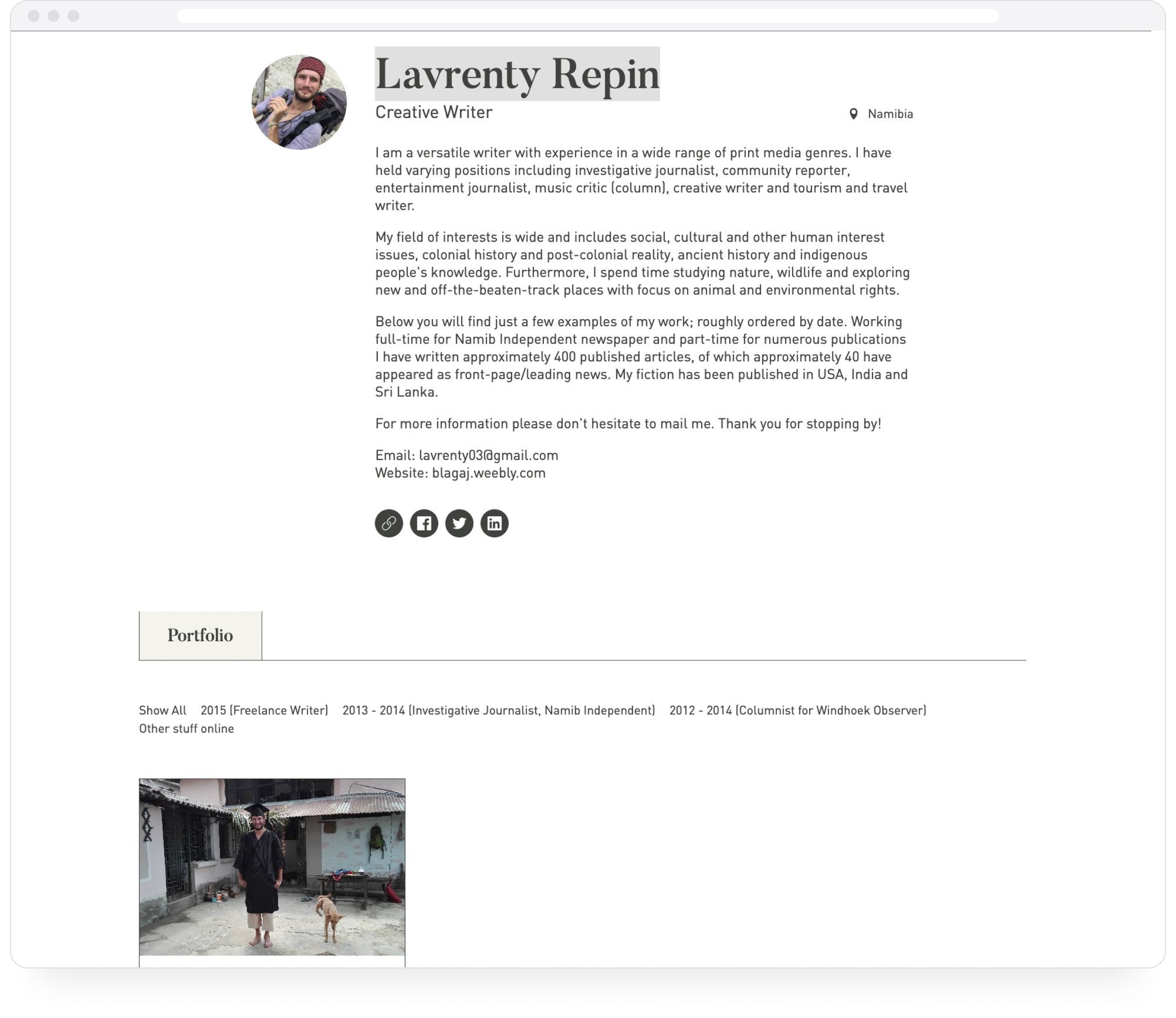
I wanted to include Lavrenty Repin's portfolio to show that your writing portfolio website can be extremely simple yet very effective. This is an older portfolio, with the last upload in 2019. Ignore that, and just focus on the fact that a white, clean background is often more than enough to grab the eye and guide it to your copywriting samples.
Lavrenty has been an investigative journalist, community reporter, entertainment journalist, music critic, creative writer, and tourism & travel writer.
When this bio was written, he was working full-time for the Namib Independent newspaper and part-time for numerous publications. At the time, he already had 400 published articles, with at least 40 of them appearing on the front page of the concerned publication.
His fiction has been published in the USA, India, and Sri Lanka.
Julian Mack
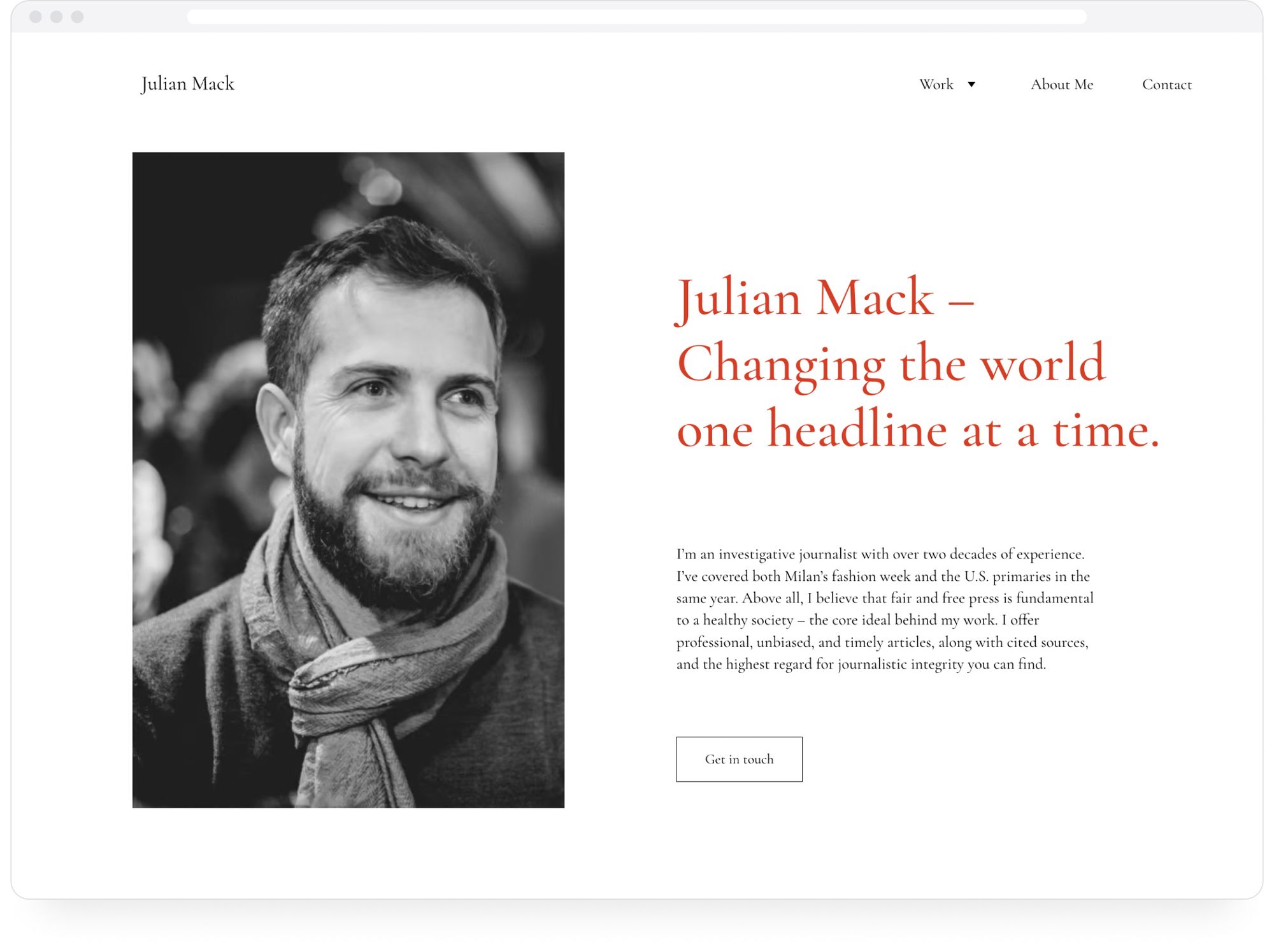
Julian Mack is an investigative journalist who has covered topics as varied as fashion and politics. He started writing when he was in school, and has been freelancing since his college days.
His portfolio showcases interesting perspectives on fashion and hot rod racing. But it's clear that he does more serious journalism, too, considering that's what he won his awards for — Journalistic Investigation Excellence (for investigating the history of gerrymandering and its consequences) and the National Media Award (awarded for investigating small government corruption).
Needless to say, his versatility immediately stands out in his minimal-aesthetic portfolio site.
Joshua Poh
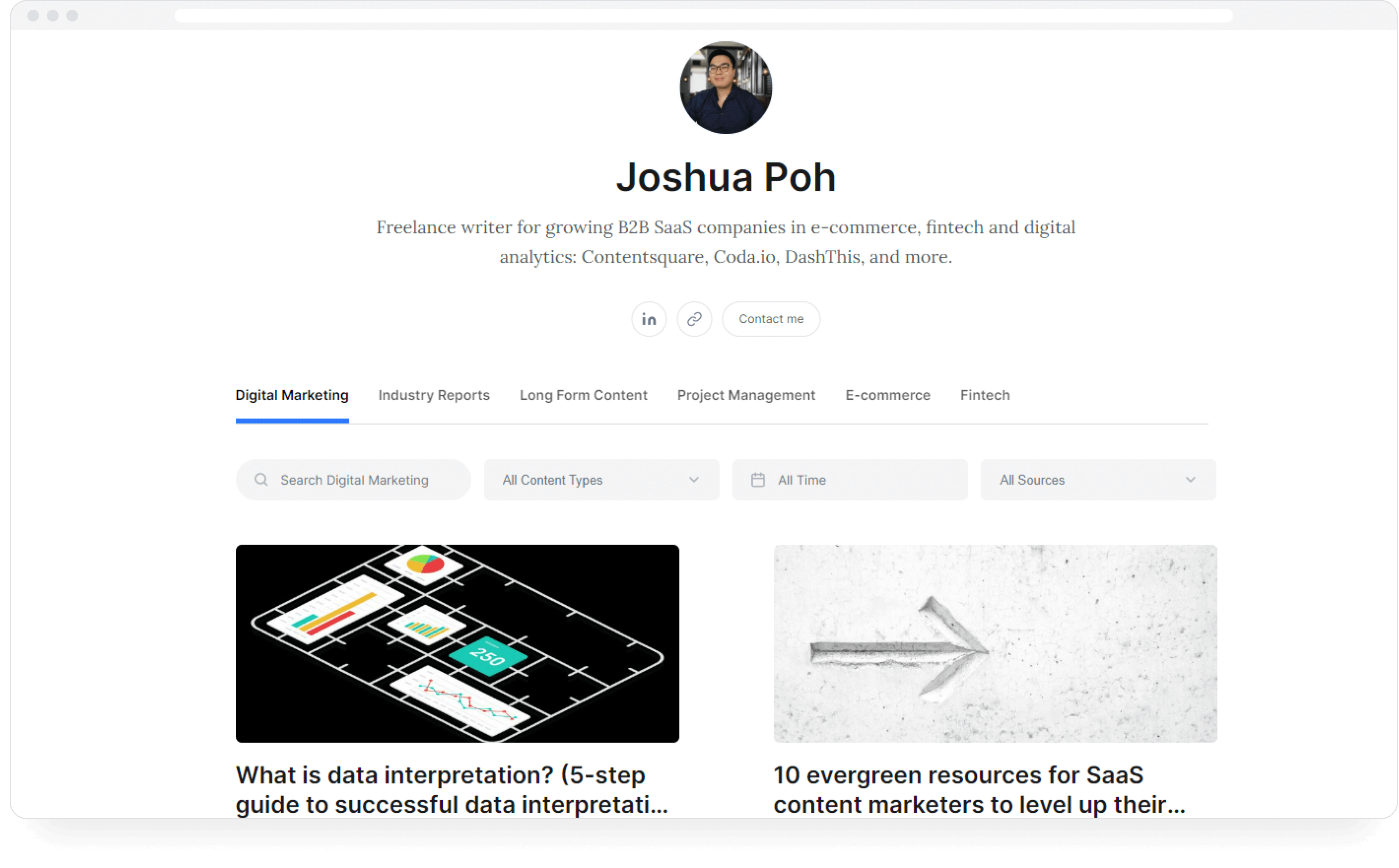
Joshua Poh has spent more than 8 years in B2B content marketing positions in high-growth technology companies across APAC and Southeast Asia. He specializes in creating long-form content that appeals to B2B audiences. His role involves helping content teams connect with clients, create brand awareness, and roll in revenue.
He is skilled at working with teams of all sizes, specializing in content marketing, long-form content creation, content repurposing, product marketing, project management, and content strategy.
Lucy Shrimpton
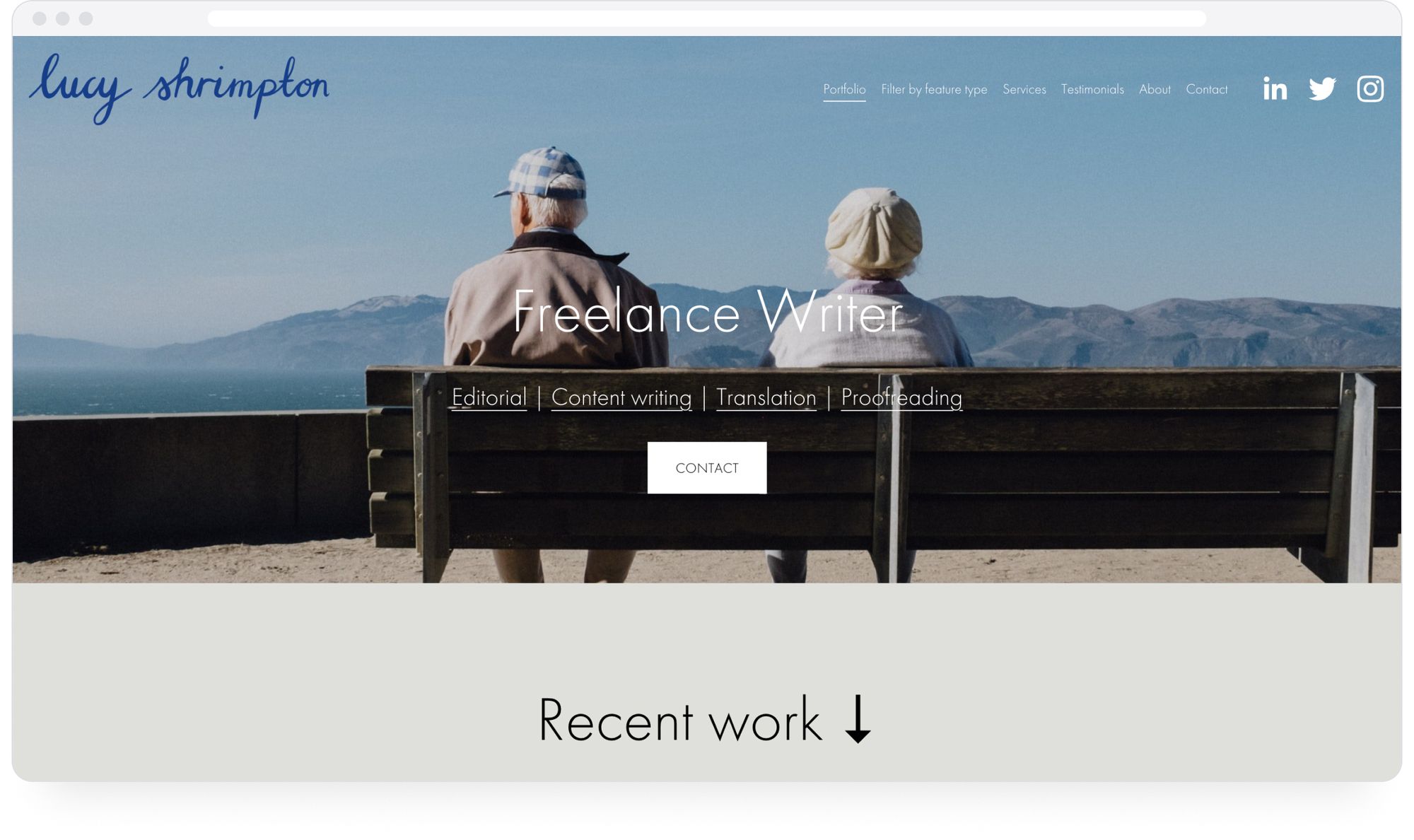
Lucy Shrimpton is a freelance writer whose works frequently appear in The Independent, Waitrose Weekend, and France Magazine. She has also written for Times Travel, Coast Magazine, Maverick, Cornwall Life Magazine, LivingEtc, and more.
You'll find her digital content at Hauts-de-France Tourisme and Calvados Tourisme. On top of that, she sub-edits and proofreads Juno Magazine, a publication dedicated to well-being, community, and parenting.
Her interests and expertise lie in history, the arts, museums, charities, books, and human-centered storytelling.
Diego Cagara
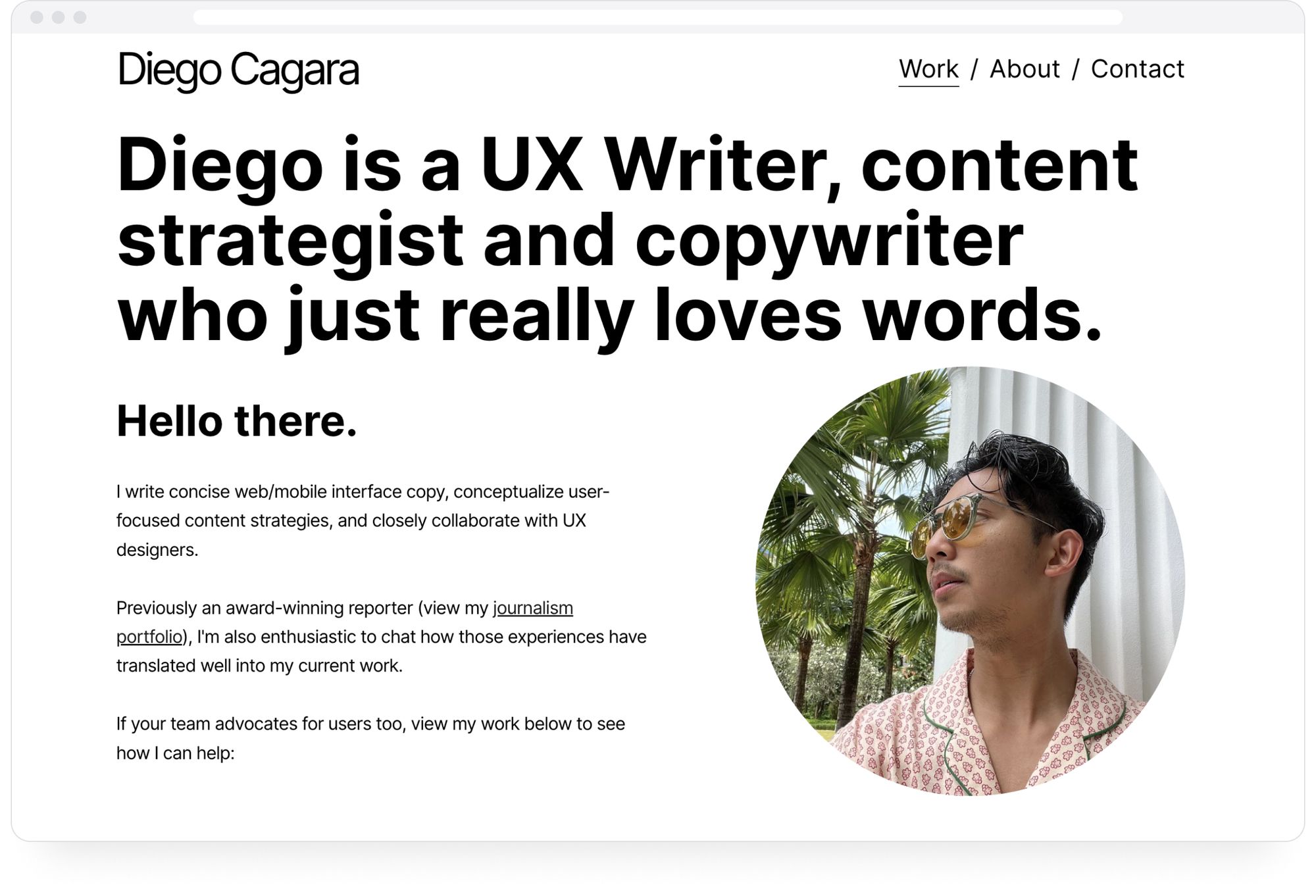
Diego Cagara has over 4 years of experience in UX writing and content strategy, and more than 6 years in copywriting and journalism.
His resume is impressive — he currently works at Meta as a content strategist, crafting user-focused B2B/B2C copy, revamped page designs, and a more streamlined information architecture.
In the past, he has worked as an award-winning journalist and copywriter for more than 7 news outlets and an ad agency. His employers include FCB Chicago, Spotlight News, and Times Union.
Diego is a constant learner, having taken multiple UX writing courses, completed solo and team projects, and earned more than a few UX writing certificates.
Anthony Murphy
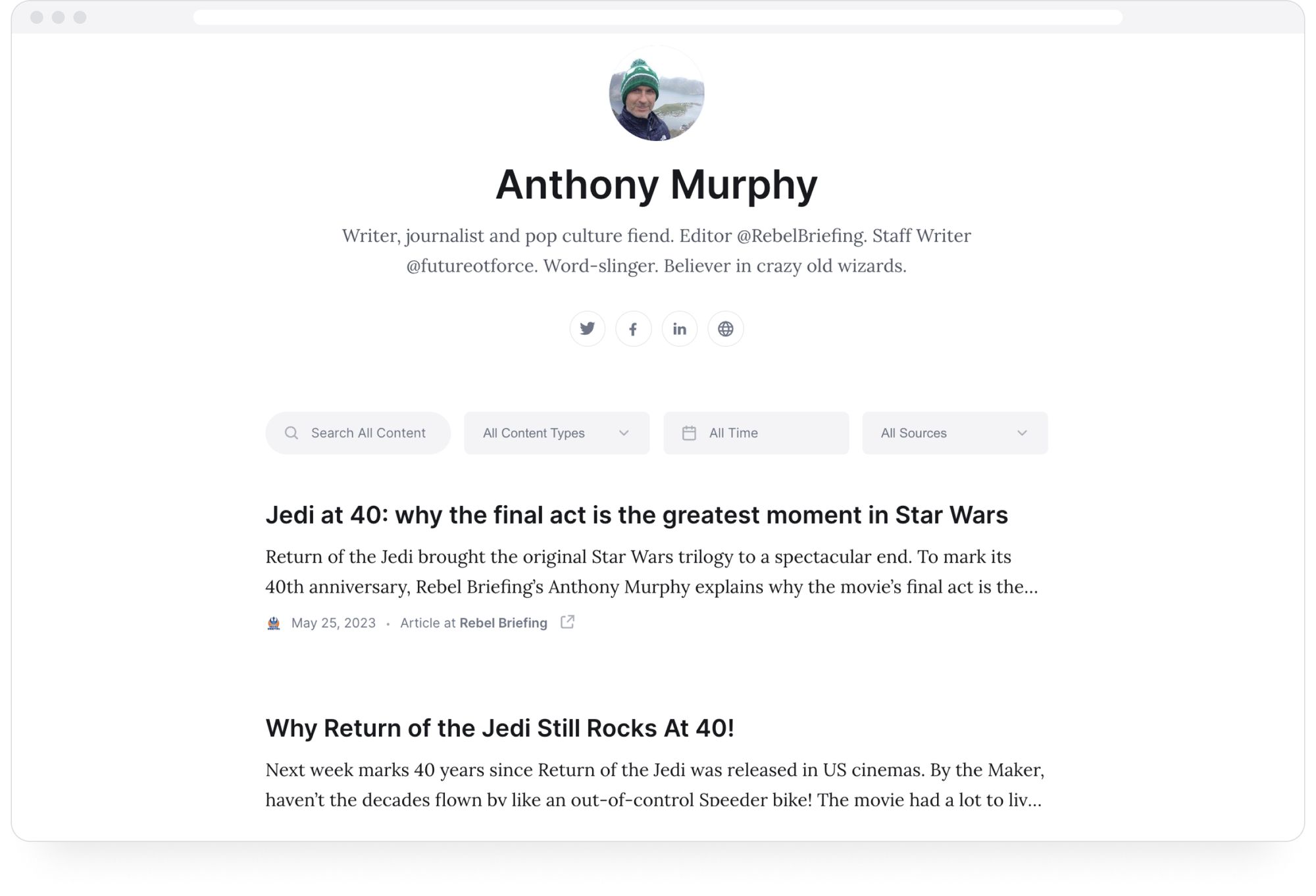
Anthony Murphy is a veteran when it comes to writing and designing news stories and features. He has worked with a wide range of content distribution formats, such as magazines, newsletters, prospectuses, newspapers, brochures, etc.
To quote his LinkedIn, he has "an exceptional talent for preparing layout of content in fantastic designs for magazines, newspapers, and brochures by using InDesign."
He also has experience with creating and deploying forward-thinking initiatives and concepts for online and printed publications with goals to improve customer relations and push revenue growth.
His specializations are impressive in number, a few being content and SEO writing, copy editing, proofreading, design and editing of publications, sub-editing, cross-team collaborations, writing press releases, marketing communications, and so much more.
Elizabeth Smith
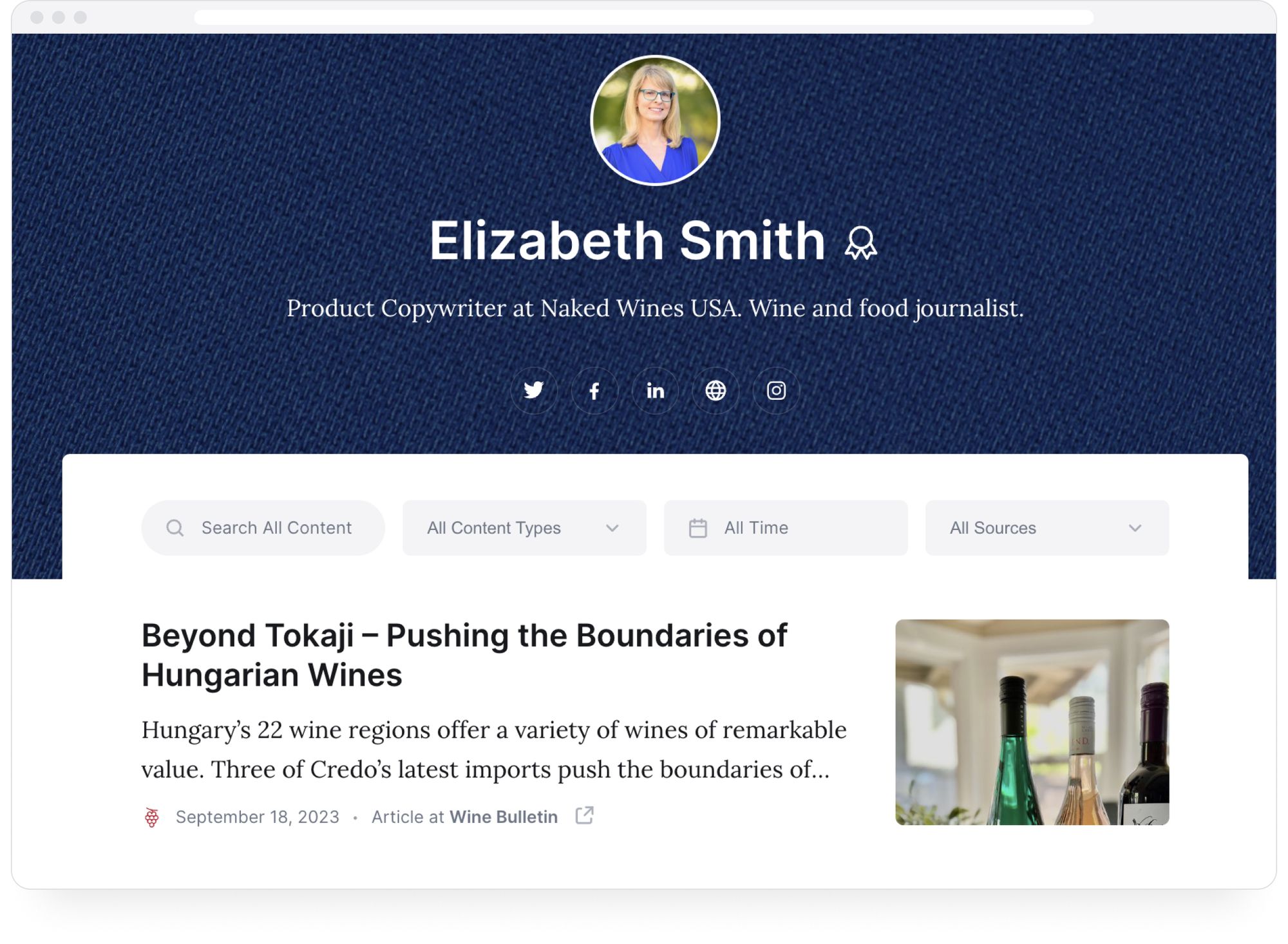
Elizabeth Smith is a former college professor and wine club manager who has now taken to copywriting and award-winning journalism. She is a full-time copywriter at Naked Wines USA, an award-winning wine journalist, and a wine competition and writing judge.
In 2017, she won the Born Digital Wine Award for Best Tourism Content with a Focus on Wine for her story, “Lodi: Beyond the Zinfandel.”
She was also a category winner in the 2022 Hungarian Web Wine Writing Competition for "2018 Wetzer Furmint, Tokaj, Hungary." Additionally, Elizabeth is also a member of Les Dames d’Escoffier International Sacramento and Sonoma chapters, the Circle of Wine Writers, and the International Food, Wine, and Travel Writers Association.
Penny Watson
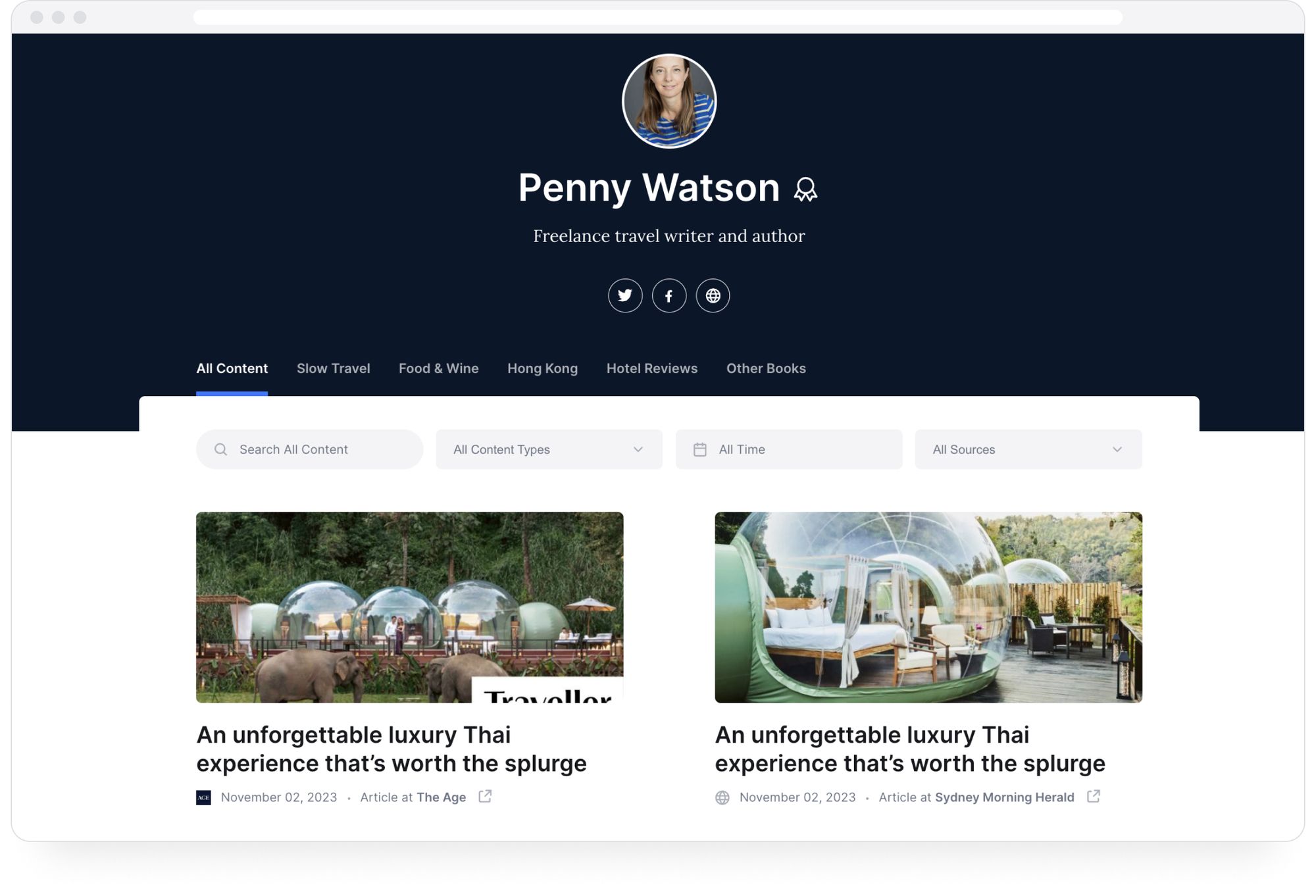
Penny Watson has been a freelance writer and professional traveler for over a decade. She has spent many years in Spain, the UK, Hong Kong, and Melbourne. Her bylines are often found in Australia’s Fairfax/Nine Traveller pages, Hong Kong’s South China Morning Post Sunday Post magazine, and Singapore’s luxury DestinAsian magazine.
She has also been featured in BBC Travel, Hong Kong Tatler, Design Anthology, and inflight magazines like Cathay Pacific (HK), Silverkris (Singapore), Mabuhay (Philippines), and Jetstar (Asia and Australia).
She has written six books, and they have been featured in CNN Travel (USA), Stuff.co.nz (NZ) and Evening Post (UK), International Traveller, InDaily, Qantas magazine, Luxury Travel, and Get Lost.
Tips to create your writing portfolio from scratch
Choose the right tool to create a writing portfolio
A tool is only "right" when it closely matches your requirements. In the case of portfolio creation, the requirements will vary based on a professional's industry, skillset, and client expectations. For instance, a graphic designer is expected to have a visually stunning portfolio — something that catches the eye and doesn't let go. The design of the portfolio serves as an example of its creator's artistic abilities.
Therefore, visually-inclined creators should choose tools that accommodate and prioritize a portfolio's appearance. Portfolio builders like Squarespace and Carbonmade are perfect examples of such tools. For photographers, there is Adobe Portfolio and SmugMug... you get the idea.
Writers, on the other hand, don't need as much visual appeal on their portfolio. Obviously, your website cannot be unsightly, cluttered, or hard to navigate. But it doesn't need to look like it could compete at a Sotheby's auction, either. A writing portfolio should be clean, clutter-free, straightforward, and easy to explore.
Therefore, writers would be best served by a tool such as Authory. This portfolio maker's primary advantage is that it does the heavy lifting (finding all your digitally published work) for you.
It's quite simple. Sign up for Authory, (it's free) and enter the URL of the website(s) on which your work is published. Within 48 hours of doing so, Authory will automatically import all your bylined content to its database, and make them available at your fingertips. The tool will also continue to import all bylined content published in the future. As long as you publish content, you'll have everything in one searchable, organized location.
Include all or the majority of your published work
Traditional portfolio-building wisdom tells us that you only include your best work in your portfolio. However, contemporary employers & potential customers want quality with quantity. Potential employers want to see that you do good work consistently and that you’re prolific in creating great work (in any format) at a decent cadence.
A great writer portfolio contains ALL or most of your work. It shows the client that you produce great work at a regular frequency, and in different domains.
If you're not sure about whether you can include a certain writing sample in your portfolio, don't forget to ask the client and get consent. In case you don't get consent and you have to show that work to a particular client (not the world), you can still make it work with a tool like Authory.
A great "About" section
Make no mistake, potential clients will read your bio or "About Me" section. This bit in your portfolio needs to sum up your achievements, digital marketing skills, and services. Don't forget to add your contact details, professional social media accounts (Facebook, LinkedIn, X, Medium, etc.) and a testimonial or two.
Open with a title, speak about your current work as a digital marketing professional, mention specializations & end with a line of personal confessions (maybe you like collecting vintage mugs, maybe you love hiking in Yosemite).
A few tips to create a great "About Me" from an actual digital marketer & SEO expert:
Start with a title that coalesces your career into a few words. I've gone for "Product-led Marketer | Startup Founder, Advisor & Consultant" to encapsulate the various aspects of my career. (I love using the "|" symbol to squeeze a few more details into my title.)
Then expand on your current career stage. So, I'd say something like,
"I'm the Director of Content Marketing at Authory."
And then, add a brief history of your recent work. I'd probably say,
"Recently, I've been in the developer-tooling industry, working primarily in the content & SEO space for companies like Hasura (Series C of $100M). I've also been a marketing consultant to numerous startups from Seed-stage to Series C."
If you like, you can conclude it by touching upon your past work. I usually go with,
"In the past, I've run a branding, advertising & digital marketing agency for over seven years, where we served over 100 clients, including conglomerates like Vodafone, Ford, ITC, and Wipro."
Categorize your content
If you're like me, you've been working with brands in diverse industries. (In my case, I've written about everything from software testing to music to "how to create portfolios" to DaaS tools for a few years now.)
If this is the case, you need to organize your content by topic, domain, or project. You really cannot expect clients to keep scrolling and clicking until they find one relevant article in a heap of unrelated content pieces.
For example, in my portfolio, I have articles under the following headers — Software testing, All The Music, Application Streaming & Cloud PCs, Creating a Work Portfolio?, Video Engineering & Streaming for Developers. Anyone can just click on one of these headers to explore the content assigned to them.
Keep your portfolio updated
Ideally, you place every single piece of content on your portfolio as soon as it is published. In the real world, however, this is easier said than done.
You can't be expected to manually upload or copy-paste every new piece of published content, especially if your work is published frequently. You have work to do, and you cannot be sleep-deprived to update your portfolio.
However, you can use a tool (like Authory) that automatically updates your portfolio with your latest work (as long as it is bylined).
Create an incredible writing portfolio site with Authory
Authory is used by many industry veterans to showcase their best writing — 6-time Emmy award winner David Pogue, Steven Levy, Editor at Large, WIRED, Brian Fung, a Technology Reporter at CNN, and many, many more.
If you're a freelance writer or even a full-time employee who wants a writer website that stands out to prospective employers, Authory can absolutely help you build your portfolio. You don't need to worry about gathering published links or choosing the right template — Authory takes care of all that for you.
Why not try Authory for free? Sign up, create your own portfolio within minutes, and let us know what you think.




